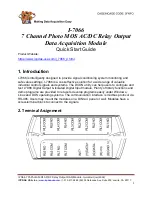
5
A
B
B
B
B
D
E
E
E
E
F
Fig.9
G
H
C
Fig.10
I
L
A
M
F
N
N
N
N
O
Piano terra finito
Finished Floor
Piastra di fissaggio Videocitofono
Mounting Plate
135cm
Quote in cm
Size in cm
Fig.8
A
Istruzioni di montaggio dei
Videocitofoni Art.3351,3451,3551
Art.3351,3451,3551
Videophones Mounting Instructions
Mounting plate
installation and PCB
connections.
A
fig.8
B fig.9
C
fig.9
D
fig.9
C
B
D
A
E fig.9
F
A
fig.9
G-H
F fig.9
fig.10
Installing the Videophone onto mounting plate
fig.10
L
A
I
fig.10
M
F
L
N
A
O
fig.10
O
Notes
!
!
!
!
!
!
!
!
Place the mounting plate
against the wall
as shown in
(135cm from floor level);
and mark the fixing holes for the four wall
plugs
(
) and for the back box
if used
(
) which must be flushed into the wall in
line with the opening
as shown in
.
Once the back box
is flushed into the wall
(if used), drill the four fixing holes and insert
the wall plugs
. Thread the cables through the opening
and fix
the mounting plate
to the wall with the 4 screws
(
), using a
Phillips screwdriver.
Fit the PCB
against the mounting plate
as shown in
;
insert the wires
(As short as possible) into terminals
. Secure
them using a terminal screwdriver.
Unclip the PCB
(
), rotate it 90º anticlockwise and fit it into its
housing as shown in
.
As shown in
, move the videophone
close to the mounting
plate
so that the ribbon cable will reach the connector .
As shown in
, connect the female plug on the ribbon cable I
coming from the videophone to the male plug connector
on the
PCB .
Place the videophone
against the 4 hooks
on the mounting
plate
and push down: the videophone will automatically lock into
place using clasp
as shown in
.
To remove the videophone from the wall, push the clasp
in the
direction of the wall with a screwdriver and at the same time push
the videophone upwards.
We recommend using a back box in order to contain excess wire
behind the back plate.
The wires must be connected to the terminals as shown on the
relevant wiring diagrams.
(1)
(2)
(1)
(2)
Applicazione a muro
della piastra di
fissaggio e collegamenti scheda di
connessione.
A
fig.8
B
fig.9
C
fig.9
D
fig.9
C
B
D
A
E
fig.9
F
A
fig.9
G
H
F fig.9
fig.10
Applicazione del Videocitofono alla piastra
fig.10
L
A
I
fig.10
I
M
F
L
N
A
fig.10
O
Note
!
!
!
!
!
!
!
!
Appoggiare al muro la piastra di fissaggio
come indicato in
(135cm da terra);
prendere i riferimenti dei quattro fori per
l’inserimento dei 4 tasselli ad espansione
(
) e, nel caso si impieghi, prendere il
riferimento per la
scatola da incasso
(
), che dovrà essere murata in posizione
centrale rispetto all’apertura
, al fine di agevolare il passaggio
dei fili come mostrato in
.
Murare (se impiegata) la scatola da incasso
, eseguire i 4 fori
ed inserire i tasselli ad espansione
. Passare i cavi nell’apertura
e fissare la piastra
con le 4 viti
(
), utilizzando un
cacciavite a croce.
Appoggiare la scheda di connessione
sulla piastra
come
mostrato in
; inserire
i fili (che devono essere più corti
possibile) nelle morsettiere
ed
e serrare con un cacciavite a
taglio.
Fissati i fili, sfilare la scheda di connessione
(
), ruotarla di
90º in senso antiorario ed infilarla nella propria sede come
mostrato i n
.
Avvicinare, come da
, il videocitofono
alla piastra
per
agevolare la connessione del flat .
Come mostrato in
inserire il
connettore del flat , che
fuoriesce dalla parte posteriore del videocitofono, nel connettore
della scheda di connessione .
Facendo corrispondere le 4 fessure presenti sulla base del
videocitofono
con i 4 incastri
della piastra
, appoggiare il
video sulla piastra e spingerlo verso il basso fino allo scatto,
compiendo un movimento come mostrato dalle frecce in
.
Per rimuovere il videocitofono, spingere con un cacciavite a taglio
il dente
verso il muro
e, contemporaneamente, tirare
il
videocitofono verso l’alto.
Si consiglia di utilizzare una scatola da incasso (non in dotazione
e reperibile sul mercato) al fine di contenere l’eventuale lunghezza
eccedente dei fili.
I collegamenti alla morsettiera devono essere eseguiti
rispettando gli schemi forniti a corredo del videocitofono (per
applicazioni differenti da quelle degli schemi standard, rivolgersi al
proprio rivenditore).
(1)
(2)
(1)
(2)






























